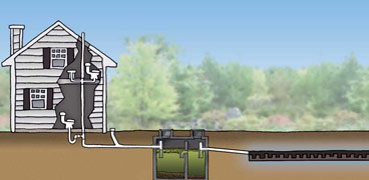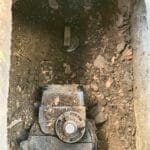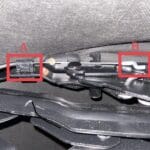Are you frustrated with land that just won’t perk for a traditional septic system? You’re not alone, and the good news is that there are alternatives that might be perfect for your property.
Whether you’re dreaming of building a new home or struggling with existing wastewater issues, finding the right solution is crucial. Imagine a hassle-free system that suits your land’s unique needs while also being kind to your budget and the environment.
You’ll discover innovative septic tank alternatives designed specifically for challenging sites. Let’s explore these options together, and see how they can transform your land into a viable, thriving space without compromising on efficiency or cost.
Aerobic Treatment Units
Aerobic Treatment Units offer an efficient solution for land unsuitable for traditional septic systems. These systems use oxygen to break down waste, ensuring effective treatment even on non-perking land. Ideal for areas with poor soil absorption, they provide a sustainable alternative to conventional septic tanks.
Are you struggling with land that won’t perk for a septic system? Aerobic Treatment Units (ATUs) might be your answer. These systems are gaining popularity for their effectiveness in treating wastewater where traditional septic systems can’t. Imagine being able to use your land without the worry of poor soil drainage. ATUs could be the solution that makes this possible.How They Work
ATUs inject air into the wastewater, promoting the growth of aerobic bacteria. These bacteria are incredibly efficient at breaking down organic matter. The process is similar to how nature purifies water in streams and rivers. ATUs typically consist of multiple compartments where different stages of treatment occur. It’s like having a mini wastewater treatment plant right under your yard.Benefits And Drawbacks
ATUs are great for challenging soil conditions. They work even in soils with poor drainage or high water tables. This means you can live in places you previously thought were unsuitable. However, they require electricity to operate. You need to consider the ongoing energy costs. They also need regular maintenance to keep them running efficiently. It’s a bit like owning a car; regular check-ups keep things working smoothly. So, could an ATU be the key to living on your dream property? It’s worth considering if traditional systems have let you down. Would you trade a bit of maintenance for the opportunity to use your land as you wish?Constructed Wetlands
Septic tanks are a common solution for waste management in rural areas, but what happens when your land won’t perk? Constructed wetlands offer an alternative, using natural processes to treat wastewater. They can be both effective and eco-friendly, harnessing nature’s power to keep your property clean and sustainable.
Design Principles
Constructed wetlands mimic the filtration abilities of natural wetlands. They are designed to allow water to flow through vegetation and soil layers, breaking down pollutants. You can choose between horizontal and vertical flow systems, depending on your space and needs.
The layout is crucial. The right plant choice is essential as they play a key role in absorbing nutrients and filtering toxins. Consider your climate and soil type when selecting plants. Grasses, reeds, and cattails are commonly used because they thrive in wet conditions.
Environmental Impact
Constructed wetlands are more than just a wastewater solution—they’re a boon for biodiversity. They provide habitats for birds, insects, and aquatic life. Imagine turning your waste management system into a thriving ecosystem.
Unlike septic tanks, constructed wetlands reduce the risk of groundwater contamination. They harness natural processes to filter and clean water, promoting healthier local ecosystems. It’s a step towards sustainable living that benefits both you and the environment.
Think about the potential for reducing your carbon footprint. Constructed wetlands don’t rely on electricity or chemicals, unlike many conventional systems. Can creating a sustainable waste solution be as simple as planting a garden?
Mound Systems
Mound systems offer a solution for land where traditional septic tanks fail. This system uses a raised bed to treat wastewater above the natural soil. It’s ideal for areas with poor drainage or high water tables. The mound system provides effective wastewater treatment and protects the environment.
Installation Process
Installation starts with site evaluation. Experts assess soil type and landscape. They design the mound based on these factors. Next, the area is cleared and leveled. Then, sand is layered on the ground. This forms the base of the mound. Pipes are installed to distribute wastewater evenly. Finally, a cover of soil and grass completes the system.
Maintenance Needs
Regular maintenance ensures the system functions properly. Check the pump and filters routinely. Clean them to prevent blockages. Monitor the mound for signs of erosion. Repair any damage promptly. Limit water usage during heavy rain to avoid overflow. Keep trees and shrubs away to prevent root intrusion.

Credit: buildingadvisor.com
Recirculating Sand Filters
Recirculating Sand Filters offer a practical solution for land that won’t perk. These systems use layers of sand to filter wastewater. They work efficiently even in challenging soil conditions. With their compact design, they fit small spaces well. This makes them a popular choice for homeowners with limited land. Understanding how these filters work can help in choosing the right system.
Filtration Mechanics
Recirculating Sand Filters operate using a layered approach. Wastewater flows into a septic tank. From there, it moves to a pump chamber. The pump sends water over a sand bed. Here, the sand acts as a natural filter. It removes solids and impurities from the water. Clean water then returns to the pump chamber. This cycle repeats until the water is clean enough for discharge.
Cost Considerations
Initial installation costs for Recirculating Sand Filters can be high. This includes the cost of the sand and other materials. Maintenance is an ongoing expense. Regular inspections ensure the system works well. Cleaning or replacing sand may be necessary. Budgeting for these costs helps in the long term. Despite the expenses, these systems are often more affordable than other alternatives.
Drip Irrigation Systems
Drip irrigation systems offer an effective solution for land that won’t perk. These systems deliver water directly to the soil. They use a network of tubes and emitters. This targeted approach ensures efficient water use. It also minimizes waste and promotes healthy soil. Drip irrigation is gaining popularity in challenging landscapes. Let’s explore how this technology works and its benefits.
Technology Overview
Drip irrigation systems use a network of tubes and valves. These components distribute water to specific areas. The system is controlled by a timer or sensor. This ensures water delivery at the optimal time. Emitters release water slowly and steadily. This prevents runoff and erosion. The slow release allows soil to absorb water efficiently. The system can be customized for different landscapes. It adapts to the unique needs of each property.
Water Conservation
Drip irrigation conserves water by targeting the root zone. This reduces evaporation and runoff. Traditional systems often waste water due to over-saturation. Drip systems use less water while maintaining plant health. This efficiency makes them suitable for areas with water restrictions. The system also reduces the risk of waterlogging. This protects plants and soil structure. Drip irrigation promotes sustainable land management. It offers a practical solution for challenging environments.

Credit: www.mecindustries.com
Holding Tanks
Holding tanks are practical solutions for lands that won’t perk. These tanks temporarily store wastewater. They don’t treat it. Regular pumping and maintenance are necessary. This makes them ideal for specific situations.
Usage Scenarios
Holding tanks are perfect for seasonal properties. Cabins or vacation homes benefit from them. These properties often have lower water usage. Holding tanks can manage this effectively. They’re also suitable for emergency situations. If a primary system fails, holding tanks can help. They provide a quick, temporary solution. This ensures sanitation isn’t compromised.
Regulatory Compliance
Regulations for holding tanks vary by location. Always check local rules first. Some areas have specific requirements. This includes tank size and installation methods. Regular inspections may be mandatory. Compliance ensures safety and environmental protection. Non-compliance can lead to penalties. Hiring a professional can help meet regulations. They ensure your system is up to code.
Composting Toilets
Composting toilets offer a practical solution for land where septic systems fail. They are efficient and eco-friendly, transforming human waste into compost. This method reduces reliance on traditional septic systems. It serves as an excellent option for non-percolating land. Learn about the advantages and workings of composting toilets.
Operation And Efficiency
Composting toilets work by separating liquid and solid waste. This separation aids efficient composting. The solids break down, transforming into usable compost. Odor control is achieved through ventilation. These toilets require little water or electricity. They are easy to maintain and operate. Regular emptying of the compost bin is necessary. This process ensures efficiency.
Sustainability Benefits
Composting toilets promote sustainable living. They minimize water usage, conserving this vital resource. The compost produced enriches soil. This reduces the need for chemical fertilizers. These toilets have a low environmental impact. They help decrease pollution from traditional systems. Choosing composting toilets supports eco-friendly practices. They are a step towards a sustainable future.
Incinerating Toilets
Incinerating toilets offer a practical solution for land where septic systems are not viable. These innovative toilets efficiently convert waste into ash, reducing environmental impact. Perfect for remote locations, they require no plumbing, making them an excellent choice for areas with poor soil drainage.
Incinerating toilets offer an innovative solution for land that won’t perk. They don’t require water or a traditional septic system. Instead, they burn waste into sterile ash. This makes them an excellent choice for challenging terrains. These toilets are compact and environmentally friendly. They also reduce water usage significantly. Let’s explore their energy requirements and safety features.Energy Requirements
Incinerating toilets need electricity or gas to function. The energy heats the chamber to a high temperature. This process turns waste into ash. Energy consumption varies by model. Some models use propane, while others use electricity. They typically consume less energy than you might think. Most units are designed to be energy-efficient. They fit well in off-grid settings.Safety Features
Safety is a priority in incinerating toilets. Many have built-in sensors. These monitor temperature and ensure safe operation. Automatic shut-off features are common. They prevent overheating and potential hazards. The exterior remains cool to the touch during use. This protects users from burns. Smoke and odor management systems are also included. They ensure clean air in your home.Choosing The Right Solution
Explore eco-friendly septic tank alternatives for land with poor drainage. Consider composting toilets, aerobic treatment units, or constructed wetlands. These options offer sustainable waste management solutions for challenging sites.
Choosing the right solution for a septic tank on land that won’t perk can be daunting. But with the right information, you can make an informed decision that suits your needs. Let’s dive into what you should consider to find the best fit for your property.Assessing Land Conditions
Start by understanding the specific conditions of your land. Is it too rocky, or perhaps it’s clay-heavy? These factors will significantly impact your choice of septic solution. A professional soil test can provide valuable insights into your land’s characteristics. This will help you determine which alternative systems are viable. It’s crucial to know your land before making any decisions.Budget And Long-term Goals
When choosing a septic alternative, your budget plays a big role. But think beyond initial costs. Consider the long-term expenses and maintenance requirements. Ask yourself: Will this system meet my needs in five or ten years? Balancing upfront costs with future expenses can save you money and headaches down the road. It’s also worth considering how this choice aligns with your future plans for the property. Are you planning to expand or build more structures? Your septic solution should accommodate these goals. By carefully weighing these factors, you can select a septic alternative that not only fits your land but also aligns with your financial and future objectives.
Credit: buildingadvisor.com
Frequently Asked Questions
What Are Septic Tank Alternatives?
Septic tank alternatives include composting toilets, aerobic systems, and constructed wetlands. These options can work without soil absorption.
How Do Composting Toilets Work?
Composting toilets break down waste using microorganisms. They do not need water or a drainage system, making them ideal for non-perk land.
Are Aerobic Treatment Units Effective?
Yes, aerobic treatment units use oxygen to break down waste. They work well for land that doesn’t perk and improve water quality.
Can Constructed Wetlands Treat Wastewater?
Constructed wetlands filter wastewater naturally using plants and soil. They are eco-friendly and ideal for poor drainage areas.
Why Choose Mound Systems?
Mound systems elevate the drain field above ground. This allows drainage in areas with high water tables or poor soil.
Conclusion
Exploring septic tank alternatives can benefit your land greatly. Traditional systems fail on land that won’t perk. Innovative options exist to solve this problem effectively. Consider composting toilets or aerobic treatment units. These systems are both eco-friendly and efficient. Costs and maintenance vary, so research carefully.
Always consult with a professional for the best fit. Choosing the right system ensures environmental safety. It also protects your property investment. Don’t let non-perking land limit your options. With the right solution, you’ll enjoy peace of mind. And a cleaner, sustainable environment.



